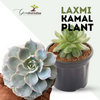


Live Indoor Air Purifying Rotundum Hybrid 'Anjamani Red' Aglaonema Plant with Pot
Guaranteed Safe Checkout
Green Paradise Beautiful Aglonema Palnt
About Aglaonema Plant
The pink aglaonema offers a perpetual touch of pink all year round. Keep soil moist and provide bright indirect sunlight. Beautiful Leaves Oxygen Giving Plant. Easy Growing Can be Grown In Total Indoor As Well.
indoor plants offer the home and office many virtues, and Aglaonemas have almost every one of them. This is a wonderful low-light houseplant and is among the easiest to maintain. They are one of the only plants which can survive long periods of time in poorly lighted and badly ventilated areas. They have large, glossy oval-shaped leaves on short stems, which arch outward elegantly and can reach 10 inches or more in length. Light: Low light. Too much light may cause its leaves to fade. Water: Keep potting mix evenly moist.
Aglaonema, also known as Chinese Evergreen, is a popular genus of flowering plants in the family Araceae. It is native to tropical and subtropical regions of Asia, particularly Southeast Asia. Aglaonema plants are cultivated for their attractive foliage and are commonly used as indoor ornamental plants.
The plants are known for their sturdy nature, low maintenance requirements, and ability to tolerate various light conditions. They typically have broad, lance-shaped leaves that come in various shades of green, often with patterns of silver, cream, or red. The variegated foliage adds a decorative touch to indoor spaces.
Aglaonema plants are valued for their air-purifying qualities, as they can remove toxins from the air, making them a popular choice for improving indoor air quality. They are often found in homes, offices, and other indoor environments.
In terms of care, Aglaonema plants prefer indirect or filtered light, as direct sunlight can scorch their leaves. They thrive in average room temperatures and moderate humidity levels. They should be watered regularly, allowing the soil to dry out slightly between waterings to prevent overwatering, which can lead to root rot.
Overall, Aglaonema plants are beautiful, adaptable, and relatively easy to care for, making them a favored choice among plant enthusiasts and beginners alike.
How To Grow Aglaonema Plant
To successfully grow an Aglaonema plant, here are some general guidelines to follow:
Lighting:
Aglaonema plants thrive in bright, indirect light. They can tolerate low light conditions, but their growth may slow down. Avoid placing them in direct sunlight as it can scorch the leaves.
Temperature:
Aglaonema plants prefer average room temperatures ranging from 65°F to 75°F (18°C to 24°C). They are sensitive to cold drafts, so keep them away from windows or doors that may cause temperature fluctuations.
Humidity:
While Aglaonema can tolerate normal household humidity, they appreciate slightly higher humidity levels. If the air in your home is particularly dry, you can increase humidity by placing the plant on a pebble tray filled with water or by using a humidifier.
Watering:
Water your Aglaonema plant when the top inch (2.5 cm) of soil feels dry. Avoid overwatering, as it can lead to root rot. Ensure proper drainage and discard any excess water that collects in the saucer.
Soil:
Aglaonema plants prefer well-draining soil that retains some moisture. A good mix can be achieved by combining potting soil with perlite or peat moss to improve drainage.
Fertilization:
Feed your Aglaonema plant with a balanced liquid fertilizer during the growing season (spring and summer) every 4-6 weeks. Follow the instructions on the fertilizer package for proper dilution and application.
Pruning:
Regularly remove any yellowed or damaged leaves to maintain the plant's health and appearance. You can also trim the tips of the plant to control its height and promote bushier growth.
Repotting:
Aglaonema plants prefer slightly crowded root conditions, so repotting is usually only necessary when the plant has outgrown its current container. Repot during the spring using a slightly larger pot with fresh potting soil.
Pests and Diseases:
Aglaonema plants are generally resistant to pests, but occasionally they may be susceptible to mealybugs, spider mites, or scale insects. Monitor your plant regularly and take appropriate measures if you notice any infestation. Also, be mindful of overwatering to prevent root rot.
By following these guidelines and paying attention to the specific needs of your Aglaonema plant, you can create a favorable environment for its growth and enjoy its beautiful foliage for years to come.






